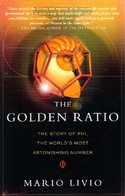- Mario Livio
-
Mario Livio Born 1945
RomaniaNationality Israeli-American Institutions Space Telescope Science Institute
Technion – Israel Institute of TechnologyAlma mater Tel-Aviv University
Weizmann Institute
Hebrew University of JerusalemKnown for The Golden Ratio: The Story of Phi, the World's Most Astonishing Number (2002) Mario Livio (born 1945) is an astrophysicist and an author of works that popularize science and mathematics. He is currently an astronomer and head of public outreach at the Space Telescope Science Institute, which operates the Hubble Space Telescope. He is perhaps best known for his book on the irrational number phi: The Golden Ratio: The Story of Phi, the World's Most Astonishing Number (2002). The book won the Peano Prize and the International Pythagoras Prize for popular books on mathematics.
Contents
Life and scientific career
Livio was born in Romania and lived with his grandparents when his mother and father were forced to flee the country for political reasons. He left Romania at age five with his grandparents, and the family settled in Israel. He served with the Israeli Defense Forces as a paramedic in the Six Day War (1967), the Yom Kippur War (1973) and the war in Lebanon (1982).
Livio earned a B.S. degree in physics and mathematics at the Hebrew University of Jerusalem, a M.S. degree in theoretical particle physics at the Weizmann Institute, and a Ph.D. in theoretical astrophysics at Tel-Aviv University. He was a professor of physics at the Technion – Israel Institute of Technology from 1981 to 1991, before coming to the Space Telescope Science Institute.
For the past decade Livio has focused his research activities on supernova explosions and their use in determining the rate of expansion of the universe. He has also studied so-called dark energy, black holes, and the formation of planetary systems around young stars. He has authored or co-authored hundreds of papers in refereed journals on these and other subjects in astrophysics. In 2009, the American Association for the Advancement of Science (AAAS) Council elected Livio as Fellow of the AAAS. Election as a Fellow is an honor bestowed upon AAAS members by their peers. Dr. Livio was cited for his "distinguished contributions to astrophysics through research on stars and galaxies and through communicating and interpreting science and mathematics to the public."[1] He is also cited in the American Men and Women of Science.
Dr. Livio has been nominated by the National Telescope Science Institute to be one of the USA Science and Engineering Festival's Nifty Fifty Speakers who will speak about his work and career to middle and high school students in October 2010.[2]
Livio and his wife Sofie, a microbiologist, have three children.
Popular works
For almost twenty years Livio has popularized abstruse subjects in astronomy and mathematics through books, lectures, magazine articles, and radio and television appearances. He has delivered popular lectures at such venues as the Smithsonian Institution, the Hayden Planetarium, the Maryland Institute College of Art, the Cleveland Museum of Natural History, and the Glasgow Science Centre. He has appeared on PBS, NPR and CBS, among other radio and TV outlets, to discuss scientific and mathematical subjects.
Livio's first book of popular science was The Accelerating Universe (2000), which explained in layman's terms the theory that the universe was expanding at a faster and faster rate. He explored the possible causes and the theoretical implications of continuing expansion, especially its implications for beliefs about the "beauty" of the scientific laws that govern the cosmos.
A self-described "art fanatic" who owns hundreds of art books, Livio put this interest to good use in his next book, The Golden Ratio: The Story of Phi (2002). He traced the influence of the golden ratio through many centuries of art, architecture, music, and even stock market theories. Dan Brown, author of The Da Vinci Code, endorsed the book stating, "Livio unveils the history and mystery of the remarkable number phi (pronounced 'fee') in such a way that math-buffs and math-phobes alike can celebrate her wonder ... you will never again look at a pyramid, pinecone or Picasso in the same light." (See the image to the upper right.)
Livio's The Equation That Couldn't Be Solved (2005) explains how efforts to solve the quintic equation led to group theory and to the mathematics of symmetry. He emphasizes the crucial roles of Évariste Galois and Niels Henrik Abel in developing this branch of mathematics. He also "keeps the hard stuff to a minimum," in the words of a Publishers Weekly review. The book contains biographical sketches of Galois, Abel and several other mathematicians.
Livio's most recent book, entitled Is God A Mathematician?, was released on January 6, 2009. It discusses the uncanny ability of mathematics to describe and predict accurately the physical world. Livio also attempts to answer a question with which mathematicians and philosophers have struggled for centuries: Is mathematics ultimately invented or discovered? The book was selected by the Washington Post as one of the best books of 2009, and it was also selected as a "2009 Borders Original Voices" finalist.
References
Books by Mario Livio
- The Accelerating Universe: Infinite Expansion, the Cosmological Constant, and the Beauty of the Cosmos, Wiley 2000, ISBN 0-471-39976-0
- The Golden Ratio: The Story of Phi, the World's Most Astonishing Number, Broadway 2002, ISBN 0-7679-0815-5
- The Equation That Couldn't Be Solved: How Mathematical Genius Discovered the Language of Symmetry, Souvenir Press 2006, ISBN 0-285-63743-6
- Is God a Mathematician?, Simon & Schuster 2009, ISBN 978-0743294058
Citations
- ^ NASA and STScI (18 December 2009). "STScI Senior Astrophysicist Mario Livio Elected AAAS Fellow". http://m.hubblesite.org/newscenter/2009/34/. Retrieved 25 January 2011.
- ^ http://www.usasciencefestival.org/2010festival/niftyfifty
External links
Categories:- 1945 births
- Living people
- Fellows of the American Association for the Advancement of Science
- Romanian astronomers
- Israeli astronomers
- Israeli science writers
- Israeli scientists
- Romanian Jews
Wikimedia Foundation. 2010.

